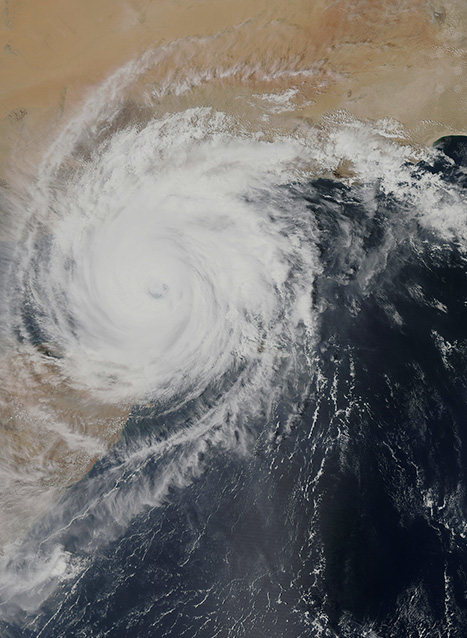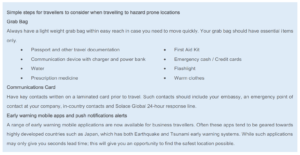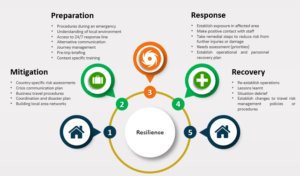Evacuations from High-Risk Locations Call +44 (0)1202 308810 or Contact Us →

Building Operational Resilience to Natural Hazards
2 Nov 2018
An increase in the frequency and severity of natural hazards, such as earthquakes, floods, hurricanes and tsunamis, is presenting additional challenges for businesses operating in areas prone to these environmental threats.Foreign visitors and expatriates are exposed to the impact of natural hazard events due to their lack of familiarity with the environment and understanding of local response measures.Travel risk management policies should focus on improving local level understanding of hazards and regional response mechanisms, ensuring their employees are fully briefed and aware of what to do in the event of environmental crisis.
Key Points
- An increase in the frequency and severity of natural hazards, such as earthquakes, floods, hurricanes and tsunamis, is presenting additional challenges for businesses operating in areas prone to these environmental threats.
- Foreign visitors and expatriates are exposed to the impact of natural hazard events due to their lack of familiarity with the environment and understanding of local response measures.
- Travel risk management policies should focus on improving local level understanding of hazards and regional response mechanisms, ensuring their employees are fully briefed and aware of what to do in the event of environmental crisis.
SITUATIONAL SUMMARY
Environmental: The human and economic cost of natural hazards is rising, far outweighing the cost of security risks, yet travel risk management policies often have limited consideration for the essential preparation and response mechanisms that should be implemented when staff are travelling to hazard prone locations. Destinations vulnerable to natural hazards are also often major commercial hubs, attracting foreign organisations and international travellers. Hong Kong, Istanbul, Jakarta, Los Angeles, Manila, Osaka and Tokyo are all cities considered highly susceptible to the impact of natural hazards, yet all have globalised economies with vast numbers of international travellers each year.
By understanding the location specific hazard profiles as well as the built environment, processes can be put in place to help prepare for, and respond to, any crisis, enhancing the sustainability and resilience of multinational business operations. In this pioneering risk management series, Solace Global will explore ways in which business can aim to reduce, or avoid, the potential losses from hazards, assure early and appropriate assistance to staff and achieve rapid and effective recovery of business operations. Our aim is to provide a toolkit that allows businesses to take control of their own vulnerabilities when operating in areas prone to natural hazards; ensuring simple steps are taken to improve the duty of care.
INTRODUCTION
Over the past 12 months, natural hazards ranging from hurricanes and typhoons to earthquakes have resulted in major economic and human losses across the planet. Such events also have lasting impacts for operational activities for organisations, creating longer-term disruption for business activities. One area that is largely unexplored, is how organisations can reduce the vulnerability of their expatriates or business travellers when they visit hazard-prone areas. Due to their unfamiliarity with an environment and the existing disaster management procedures in place, foreign visitors, including business travellers, are one of the most exposed demographics when natural hazards strike. Even a comparatively minor event can quickly become a disaster event for those involved without the adequate mitigation measures in place.
The natural hazard series will use the term ‘disaster’ selectively. A natural disaster suggests that the magnitude of the event exceeds the capacity of an organisation, to plan for, and respond to, the event. While in some cases this could be considered a true statement, risk management policies and processes must work from basis that a disaster is an intersection between two points, the hazard and the vulnerability of the traveller. The hazard remains an immovable part of the equation, however vulnerability is something that can be reduced through effective preparation actions. To build sustainable and resilient travel risk management policies, all steps should be taken to focus on consistently minimising the vulnerability of your travellers to specific hazards.
MITIGATION and PREPAREDNESS (pre-trip)
Natural hazards cannot be prevented; however, businesses can develop and implement policies and procedures that will protect both their employees as well as their business assets from the impact of a natural events, thereby limiting the potential for harm. The first stage of this process should be part of a robust risk assessment. Pre-trip risks assessments should identify the likelihood of natural hazard events alongside the exposure of your traveller(s) to these hazards. By assessing and understanding threats, strategies can then be devised that start to put in place measures to mitigate the risk. Assessments should identify location-specific vulnerabilities and ensure travel plans consider factors such as early warning systems, physical infrastructure, communication, health service and local response capabilities. Through identifying vulnerabilities, strategies can be put in place to minimise the impact of existing weaknesses.
Another key consideration is preparing your staff before they travel by briefing on the prevailing environmental hazards, improving their situational awareness of the risks, and providing advice on what actions to take if a natural hazard does occur. Location and itinerary specific threat assessments will help improve a traveller’s situational awareness and therefore their ability to effectively plan and think ahead in the event of a crisis. By educating and working with staff prior to their travel, they should arrive in-country with a clear understanding of what their responsibilities are, should a major hazard occur and have confidence in a viable response plan.
Companies should also be able to quickly understand their employee exposure in a country affected by a natural hazard, establishing where staff are located, primary and secondary contact details as well as their planned daily itineraries. By establishing systems that track exposure on an easy to understand system, response activities can begin much sooner, ensuring that if employees are severely affected – the right assistance reaches them quickly.

RESPONSE and RECOVERY (during and post-trip)
Developing a concept of operations (CONOPS) for crisis situations in areas where you operate will ensure you have a plan of action that can be rapidly put in place following a hazard. A CONOPS should consider the main points highlighted below but remain flexible and able to adapt to different scenario and situations.
Communication
Establishing communication with employees after an incident remains the priority once a company knows they have travellers in an area affected by a natural hazard. Primary and alternative communication should have been established prior to travel. Telecommunication systems remain weak points during environment hazards so alternative communication should be via a secondary communication platform, this can include a satellite phone (dependent on the individual countries laws) however; internet-based communication system also often provide a suitable alternative communication platform. Web based applications (such as Facebook and WhatsApp) will work with viable internet connection which is often more robust than telephone networks.
Information
Information management is central to ensuring that your staff on the ground are receiving the correct advice regarding what actions to take. Following any major natural hazard event, the sheer quantity of information can result in inaccurate and inadequate information reaching people. It is essential that information is managed centrally and only verified information helps guide movement or response activities on the ground. This can often be difficult to manage during a crisis; however, remains critical to guiding effective responses.
Movement
If employee movement is required following a natural hazard event, any non-time critical movement should be supported by in-country logistics or security providers with a good understanding of the local environment. If urgent movement is considered critical, the employee should be supported with intelligence and clear guidance on where to move.
Emergency Assembly Area
Several pre-established and assessed emergency assembly areas (EAA) should have been established prior to travel and will provide a point for employees in country to assemble in a safe area with basic resources. This is typically at a hotel, club or residence that provides good security, multiple access/egress routes, accommodation, food, water and power. From this point planning can start to move affected employees out of the impacted area back to their home country. If ports of departure, such as airports, are closed due to the impact of the natural hazard, EAAs will provide a safe location to look at all options for movement in the short term.
Evacuation
The final consideration should be moving employees to a point of departure and out of the affected country. Dependent on the severity of the hazard, basic infrastructure, such as roads, could be severely damaged and government services, such as policing, could be overwhelmed. It might be therefore essential to work with in-country logistics or security providers to support a road move to a point of departure and ensure your employees can access their flights without any issues. Contact with airlines should be maintained as flights can often be overbooked and seats assigned on a first come first serve basis.
Evaluation
Any crisis provides an opportunity for organisations to learn. Following any major event that affects your staff, lessons learnt should be captured and fed back into your travel risk management policies and procedures.

SECURITY ADVICE
EnvironmentModerateTravel Risk Management
OUR SOLUTIONS
Pre-travel planning
Expert advice on where you are going help your personnel understand the threats, focusing on natural hazard impacts, necessary to have a safe and successful trip. Our team can plan, and journey manage your trip wherever you go in the world.
Intelligence, due diligence & risk assessments
Our intelligence division produces travel advisories and intelligence alerts, together with client-specific country risks, journey itinerary and major event reporting. Further we can offer country-specific escalation and evacuation planning as well as business-specific concept of operations to support natural hazard preparedness.
Ongoing advice:
Anytime you need further information or advice, you or your staff can contact our 24/7 centre for the latest verified information and crisis support.
Training
Whether situational awareness, travel safety training, basic medical or kidnap and ransom response; our courses can be tailored to client destinations, risk and requirements and can be run face to face, via webinar or online e-learning courses.
Technology
Receive real-time alerts direct to phone or desktop, review global incidents before and during a trip, and monitor threats in relation to where you or your personnel are (with geo-fencing, check-in and SOS functionality).
Monitoring
The Solace team can also pro-actively monitor your personnel and assets for you, and respond immediately in the event of crisis, contacting the employees in the affected area, making sure they are safe and putting in place a plan to move them if necessary.
Journey management & travel security
From meet and greet services and in-country close protection security, to embedded security or medical consultants; we offer a full suite of services to keep your people and assets safe.